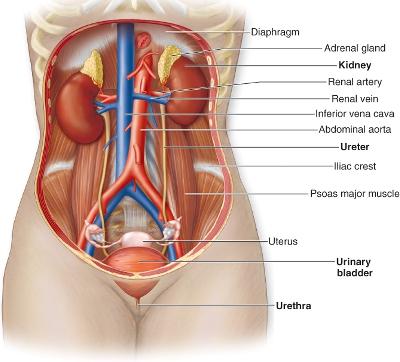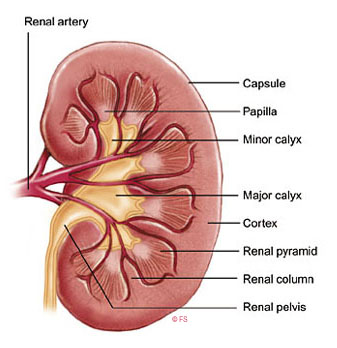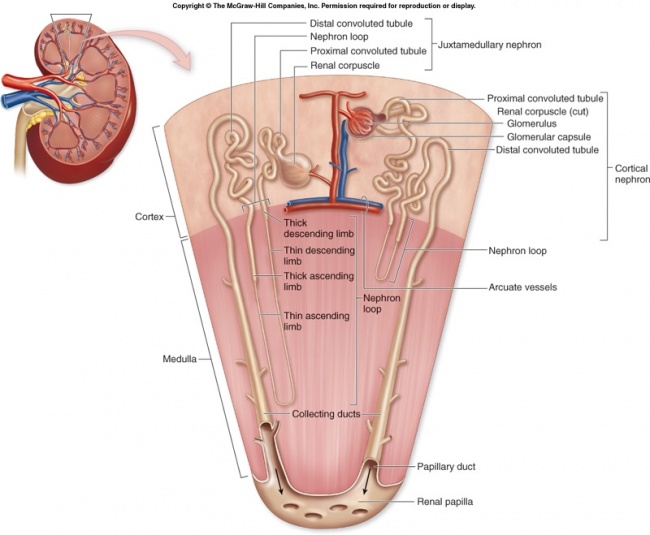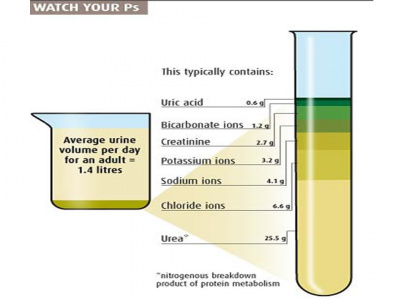Anatomy/Excretory System
The excretory system is a topic of the event Anatomy. This system was tested for Division C in 2012 and 2013, rotating in for the first time in Division B in 2019.
Overview
The urinary system consists of the kidneys, two ureters, the urinary bladder, and the urethra. Blood flows through the kidneys as they filter out waste such as urea. The urine produced by the kidneys goes through the ureters. It then waits in the urinary bladder, until it goes out through the urethra.
Gross Anatomy of the Kidney
The body's two kidneys are kidney-bean shaped organs that are located in the superior lumbar region. The right kidney is slightly inferior due to crowding by the liver. They are each about 12 cm by 6 cm by 3 cm. The convex side is located laterally.
The medial indentation, known as the hilus of the kidney (or renal hilum) is where the ureters, renal blood vessels, and nerves enter or exit the kidney. The adrenal glands are located immediately superior to the kidneys; they are part of the endocrine system, involved in the production of a variety of important hormones.
The kidneys are surrounded by a fibrous, transparent renal capsule and a fatty mass known as the adipose capsule. The adipose capsules serve to protect the kidneys and hold them in their positions.
The tissue of the kidney is divided into two parts:
- Cortex - outer layer
- Medulla - inner layer, the renal pyramids collectively
Other major structures include:
- Renal Columns - extensions of the cortex that divide the medulla into pyramids
- Renal Pyramids - point toward the renal pelvis
- Terminate at a minor calyx
- Minor Calyx - connective and muscular tissue which collects urine (extension of the ureter)
- Striped appearance results from the straight segments of the nephrons that spans the pyramids
- Terminate at a minor calyx
- Renal Pelvis - leads out of kidney from the hilum to ureter
The primary function of the kidney in the excretory system is filtration, secretion, and reabsorption of water, solutes, and waste products. Nephrons extending between the cortex and medullar are the functional unit of the kidney involved in these processes and are discussed in the next section.
The Nephron
The nephron is the functional unit of the kidney. It is a tube-like structure that spans the renal cortex and medulla. The average human kidney contains 800,000- 1.5 million nephrons. The nephron is the site of ion and water reabsorption, and where urine is produced.
The nephron has five regions.
- Glomerular (Bowman's) capsule
- The inner layer of the capsule is composed of cells called podocytes. They have long, branching processes that cling and intertwine with each other, forming a porous membrane around the glomerulus, which is the mass of capillaries within the capsule.
- The blood pressure within the glomerulus is extremely high due to the differences in diameter between the large afferent arteriole and the narrower efferent arteriole. This forces fluids and solutes into the glomerular capsule.
- Proximal Convoluted Tubule (PCT)
- The PCT is a highly coiled region, which is closely associated with the peritubular capillary bed.
- It is the site of early reabsorption of water, ions, glucose, and amino acids
- Nitrogenous wastes and blood pollutants such as medications are secreted
- By the end of the PCT, 60% of the original water is reabsorbed, and 65% of original ions
- Loop of Henle
- The descending segment is the site of water reabsorption. This is a passive process, which occurs via osmosis due to the ion gradient created by the ascending segment.
- The ascending segment is the site of ion reabsorption, which occurs via active transport.
- By the end of the Loop of Henle, 80% of the original water is reabsorbed, and 90% of the original ions.
- Distal Convoluted Tubule (DCT)
- This is the site of the secretion of any extra wastes.
- Collecting Duct
- The main function is the absorption of more water. It relies on the solute gradient created by the Loop of Henle.
Collectively, the PCT, Loop of Henle, and DCT comprise the renal tubule. The tubule is lined with microvilli, which increase the surface area.
Associated Vessels
- Afferent arteriole transports blood into the...
- Glomerulus (capillary bed), where it then moves into the...
- Efferent arteriole, which leaves the nephron. It is much narrower than the afferent arteriole, causing high pressure and encouraging filtration.
- Peritubular capillaries are capillaries that arise from the efferent arteriole. Their main purpose is resorption of the solutes and water from the tubule cells.
- Vasa recta capillaries are the portions of the peritubular capillaries that surround the Loop of Henle.
Nephrons may be classified by their location. Most nephrons are located almost completely within the cortex, and are called cortical nephrons. Nephrons that are found close to the boundary between the cortex and the medulla, and whose loops of Henle are mainly within the medulla are known as juxtamedullary nephrons.
Functions
- Excretion- remove waste products from the blood
- Regulation of blood volume and pressure- kidneys control amount of extracellular fluid, can make dilute or very concentrated urine
- Regulation of the concentration of solutes in the blood- kidneys regulate molecules and ions like glucose, sodium, hydrogen carbonate
- Regulation of red blood cell synthesis- kidneys secrete erythropoietin, which regulates blood cell production in bone marrow
- Vitamin D synthesis- kidneys control blood levels of calcium by regulation synthesis of vitamin D.
Urine Production
Filtration- The passive process by which the filtrate is formed. Filtrate is identical in composition to blood plasma without the proteins, which are too large to pass through the glomerular capsule.
Reabsorption- The process of reclaiming useful substances from the filtrate such as water, ions, glucose, and amino acids. These substances are passed out of the tubules and into the extracellular space, where they are reabsorbed by the peritubular capillaries. This is mainly an active process, with the exception of water, which moves by osmosis. The active transport is carried out by selective membrane carriers. This process is important in the regulation of homeostasis.
Secretion- This is used to move more substances into the filtrate, either from the peritubular capillaries or the tubule cells. This process is also used in the removal of drugs from the body and as an additional method of regulating blood pH.
Bladder
The bladder is a muscular sac that holds urine. It can hold a maximum of 700-800 ml of urine. It has a specialized stretch receptor that sends a nerve impulse to the spinal cord, resulting in contraction of the bladder muscles and relaxation of the internal sphincter. However, the stretch receptors send the first impulse when there are only 200 ml of urine in the bladder.
Urethra
The urethra is the tube that connects the bladder to the genitals and transports urine out of the body. There are two sphincters in the urethra; the internal (involuntary) sphincter at the junction of the bladder and urethra, and the external (voluntary) sphincter which is distal to the prostate in males, and just inferior to the internal sphincter in females.
Substances Removed by Kidneys
Most of the substances removed are metabolic wastes, produced as by-products from normal body function. Some of the most toxic include the nitrogenous wastes.
- Urea- produced in the liver by protein metabolism
- Uric Acid- produced in the liver by metabolism by nucleic acid metabolism
- Creatinine- produced in muscles by protein metabolism
Vocabulary
- (Re)Absorption- movement of a solute across a membrane and incorporation into the body
- Secretion- release of a solute across a membrane, out of the body, in this case from the peritubular capillaries into the tubule.
- Excretion- filtration and removal of solutes out of the body
- Solute- a substance that is dissolved in the blood plasma (ions, waste chemicals, toxins, etc.)
- Clearance- the rate at which a solute is filtered from the blood plasma
Urine
Urine is a waste product which is produced by the kidneys during the process of filtering the blood and is made up of water and other dissolved waste products. It is a typically yellowish fluid which is stored in the bladder and is discharged through the urethra. The average urine volume for an adult in a day is around 1.5 liters. Urine is produced at a rate of about 30mL per hour.
Composition of Urine
Urine consists of mostly water and then some other chemicals and compounds. The approximate composition of urine is listed below from highest proportion to lowest.
- Water - 95%
- Urea - 2%
- Chloride - .6%
- Potassium - .6%
- Sulphate - .18%
- Phosphate - .12%
- Sodium - .1%
- Creatinine - .1%
- Ammonia - .05%
- Uric Acid - .03%
- Calcium - .015%
- Magnesium - .01%
Disorders
Kidney Stones
- General Overview:Kidney stones (renal lithiasis, nephrolithiasis) are hard deposits made of minerals and salts that form inside your kidneys.
- Cause:
- Symptoms:
*Pain in the back, belly or side
*Pain or burning during urination
*Urgent need to go
*Blood in the urine
*Cloudy or smelly urine
*Going a small amount at the time
*Nausea and vomiting
*Fever or chills
- Treatment: One treatment option is shock wave lithotripsy. This treatment uses shock waves to break up the kidney stones into small pieces. After the treatment, the small pieces of the kidney stone will pass through your urinary tract and out of your body with your urine.
Urinary Tract Infections
- General Overview: Infection in any part of the urinary system
- Cause:bacteria in the urinary tract, most commonly E. coli
- Symptoms:
*persistant urge to urinate
*burning sensation during urination
*cloudy or red urine
*strong smelling urine
- Treatment:
•drink more liquids
•proper hygiene
Glomerulonephritis
- General Overview: inflammation of the glomeruli
- Cause: Can be caused by infections or occur alongside another disease, such as diabetes
- Symptoms: pink, foamy urine
•swelling
• high blood pressure
- Treatment: Acute may pass on its own
•Treating the underlying cause (infection, disease)
Renal failure
- General Overview: Kidney loses its ability to filter substances. Can be acute or chronic, which has 5 stages. A Glomerular Filtration Rate of under 15 indicates renal failure.
- Cause: diabetes is the most common cause
•can be genetic
•high blood pressure
- Symptoms:
•too much or not enough urine
•back pain and muscle cramps
- Treatment:
•dialysis
•kidney transplant
Incontinence
- General Overview: Loss of bladder control and control of urination.
- Cause:
•can occur due to pressure when coughing or laughing
•can occur due to other diseases, such as diabetes
•bladder overflow
- Symptoms: involuntary urination
- Treatment: medications that relax the bladder muscles, such as Oxybutynin
Prostatitis
- General Overview: swelling of the prostate
- Cause:
•can be caused by bacterial infections • can be caused by nerve damage in lower urinary tract
- Symptoms:
•painful and difficult urination • frequent urination •dark or cloudy urine
- Treatment: Can pass on its own, or antibiotics can be used
Benign Prostatic Hyperplasia
- General Overview: prostate gland enlargement that can cause difficulty in urination
- Cause: Age-associated
- Symptoms:
-frequent need to urinate
-inability to empty bladder fully
-urinary tract infection
- Treatment: medications that relax the bladder, such as Tamulosin
Glomerulosclerosis
- General Overview: Hardedning of the glomeruli in the kidney.
- Cause: scarring of glomeruli, diabetes, HIV, and other diseases
- Symptoms: Edema, foamy urine, high cholesterol, proteinuria, weight gain
- Treatment: Steroids such as prednisone to control proteinuria, ACE inhibitors, or Angiotensin receptor blockers





